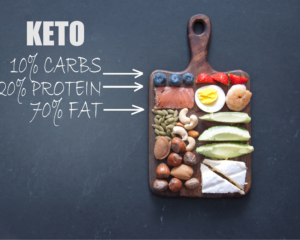Keto Diet Explained: 5 Essential Steps to Get Started
The Keto diet has become increasingly popular as an effective and long-term weight loss solution. But with so many different diets and nutrition plans out there, it can be hard to know where to start. In this article, we’ll explain what the Keto diet is all about, how it works, and provide five essential steps to get started.

What is the Keto Diet?
The Keto diet is a type of low-carbohydrate diet that focuses on reducing carb intake and increasing fat intake. This kind of diet has been shown to be very effective for weight loss and can also lead to numerous health benefits, including improved blood sugar levels, increased energy, and improved mental clarity.
The main idea behind the keto diet is that by reducing carbohydrates and increasing fat consumption, your body will enter a state called “ketosis”. During ketosis, your body starts to use fat as its primary energy source instead of carbohydrates. This process helps you burn stored fat for energy, which in turn leads to weight loss.
How Does the Keto Diet Work?
In order to enter ketosis, you must drastically reduce your carb intake while increasing your fat intake. Your daily calorie intake should be made up of around 70-80% fat, 20-25% protein, and 5-10% carbs. This ratio should be kept consistent in order to maintain ketosis.
Once you’ve entered ketosis, your body will start to burn stored fat for energy instead of carbohydrates. This process can lead to rapid weight loss as well as numerous health benefits such as improved blood sugar levels, increased energy, and improved mental clarity.
5 Essential Steps to Get Started on a Keto Diet
1. Calculate your macros. Before you start the Keto diet, you should calculate your ideal macronutrient ratio (the ratio of fat, protein, and carbs). This ratio should be around 70-80% fat, 20-25% protein, and 5-10% carbs. Once you’ve calculated your macros, you can start planning your meals accordingly.
2. Eliminate processed foods. Processed foods are often high in carbs and unhealthy fats which can interfere with ketosis. Try to focus on eating whole foods such as meats, vegetables, nuts, seeds, and healthy fats.
3. Increase your fat intake. Since fat is the primary source of energy on a keto diet, it’s important to increase your consumption of healthy fats such as olive oil, coconut oil, avocados, nuts and seeds.
4. Reduce your carb intake. To enter ketosis and stay there, it’s important to reduce your daily carb intake to around 5-10%. This includes eliminating or limiting starchy vegetables such as potatoes and corn as well as sugary foods like candy and soda.
5. Track your progress. To make sure that you’re staying in ketosis and getting the most out of your diet plan, it’s important to track your progress using tools such as food logs or fitness trackers. By tracking your progress regularly, you can make adjustments if needed in order to stay on track.
Conclusion
The Keto diet is an effective way to lose weight and improve overall health. By following the five steps outlined above, you can get started on this popular diet plan and begin seeing results in no time! However, it’s important to remember that everyone’s body is different so it may take some time before you reach optimal results from this diet plan.